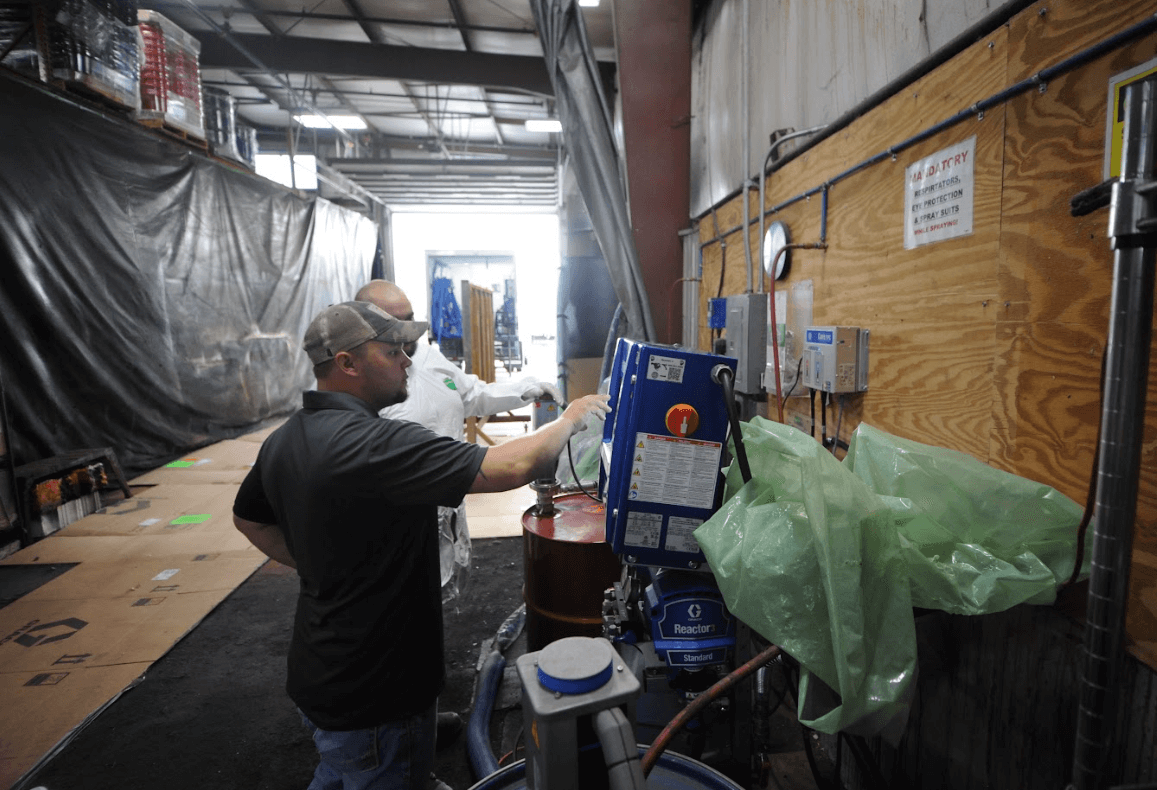Cellulose Insulation vs Spray Foam: Which Is Right for Your Project?

As contractors and spray foam applicators, you know that insulation plays a critical role in ensuring energy efficiency, comfort, and cost-effectiveness for your customers.
Spray foam and cellulose insulation are two common insulation options for homes and businesses. When it comes down to cellulose insulation vs spray foam — which is better?
To help you better educate your clients and choose the right solution for each project, let’s explore the key differences between these materials, their benefits, and scenarios where each may be the best fit.
Key Differences Between Spray Foam and Cellulose Insulation

Blown cellulose and spray foam differ in some key areas, including composition, R-value, and in their overall effectiveness.
Composition and Installation
- Spray Foam Insulation: Made from a combination of isocyanate and polyol resin, spray foam is applied as a liquid that expands into a foam. As it expands, it creates an airtight seal and fills gaps, making it ideal for irregular or hard-to-reach spaces. It comes in two types: open-cell and closed-cell.
- Cellulose Insulation: Composed primarily of recycled paper products treated with fire retardants, cellulose insulation is typically blown into walls, attics, and other spaces.
R-Value (Thermal Resistance):
- Spray Foam: Spray foam boasts a higher R-value per inch. Closed-cell spray foam has an R-value of R-6.5 to R-7 per inch, while open-cell spray foam offers an R-value of about R-3.5 to R-4 per inch.
- Cellulose Insulation: Cellulose offers a decent R-value, but is still not as high as spray foam. It’s generally around 3.2 to 3.8 per inch, depending on the density and application method.
Air and Moisture Barrier
- Spray Foam: High-quality spray foam provides an effective air barrier and serves as a moisture barrier, reducing the risk of mold and mildew. This is a key selling point for clients concerned about indoor air quality and structural integrity, especially in attics and basements.
- Cellulose Insulation: While it provides good coverage and some resistance to airflow, it is not as effective as spray foam in sealing air leaks. It also doesn’t mix well with water and may mold or mildew in damp areas.
Durability and Longevity
- Spray Foam: Known for its durability, spray foam insulation lasts for decades. The rigid structure of closed-cell foam helps add strength to buildings and resists settling and degradation.
- Cellulose Insulation: While it provides effective insulation initially, cellulose can settle over time, reducing its R-value and insulating performance. Settling is a common issue with cellulose insulation, which can create gaps and reduce its effectiveness. Regular checks and maintenance are key to mitigating this problem.
Cost
- Spray Foam: While spray foam is generally more expensive upfront due to the cost of materials and professional installation, it can lead to significant long-term savings on energy bills.
- Cellulose Insulation: Cellulose insulation is less expensive initially and can be installed by your team or clients themselves, making it a budget-friendly option for many projects. That said, it may require maintenance and upkeep, which can reduce cost-savings over time.
When to Choose Cellulose vs Spray Foam Insulation
Now that you understand the key characteristics of both types of insulation, it’s time to determine which one is right for the project at hand.
“Choosing between the two insulations really depends on location of property, the customer’s budget, and the length of time they plan on owning the property.”
— Jed Stellmacher, owner at Oak Ridge Foam & Coating Systems, Inc.
Spray Foam
Spray foam insulation is ideal for a variety of residential, industrial, and commercial facilities. It’s particularly useful in potentially damp areas, like basements, attics, sheds, and RVs.
With so many applications, spray foam provides numerous opportunities to support customers and grow your business in new ways.
- For Maximum Energy Efficiency: If your customers are looking to achieve the highest possible energy efficiency and long-term savings, spray foam is the way to go. It’s ideal if they plan to live in their home long-term or live in extreme climates.
- In Moisture-Prone Areas: Are you insulating basements, crawl spaces, attic, or other areas where moisture control is essential? Spray foam is going to provide your customers with the most moisture protection.
- For Sealing and Insulating: When your customers need both insulation and air sealing, spray foam provides a comprehensive solution.
Cellulose Insulation
- For a Budget-Friendly Option: If cost is a primary concern, cellulose insulation offers good performance at a lower initial price point. However, it’s important to note the durability, longevity, and replacement costs that can quickly add up in the long-run.
- For Eco-Friendly Projects: If sustainability is a priority, cellulose’s use of recycled materials makes it an attractive choice. That said, it still uses some chemicals to flame-proof the material.
- Fire Protection: If fire protection and resistance are the top priorities, such as in kitchens, blown-in cellulose insulation may be a good option due to the chemical treatment to minimize flammability.
- Retrofitting Interior Projects: Cellulose is often an OK choice for existing interior structures where it can remain dry and be blown into wall cavities without major renovations.
We’re Here for All Your Spray Foam Insulation Needs

While choosing the right material is important, it’s only one piece of the puzzle. For expert advice, comprehensive training, and the best spray foam and equipment on the market, contact our team today.
“As a leading spray foam supplier nationwide, we are here to support you in delivering optimal comfort and energy efficiency to your customers.”
— Jed Stellmacher, owner at Oak Ridge Foam & Coating Systems, Inc.
Learn More
